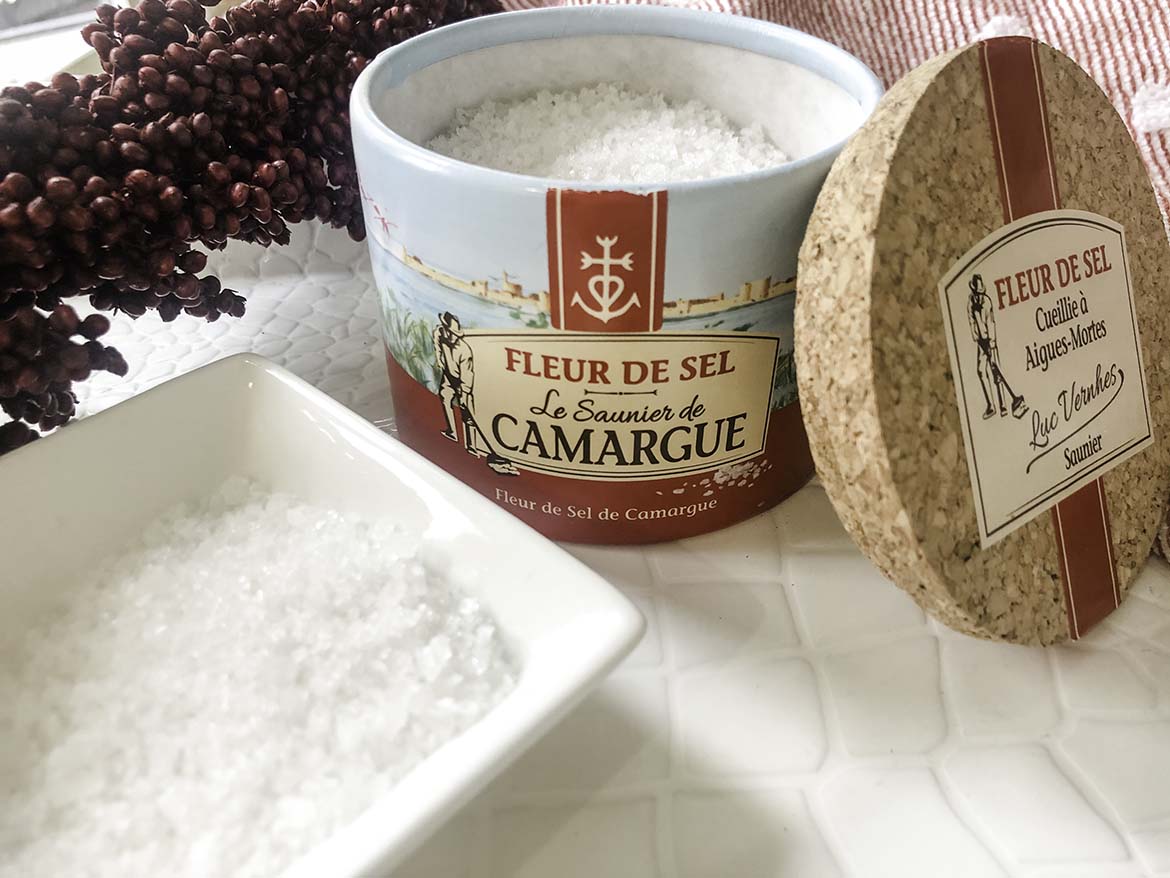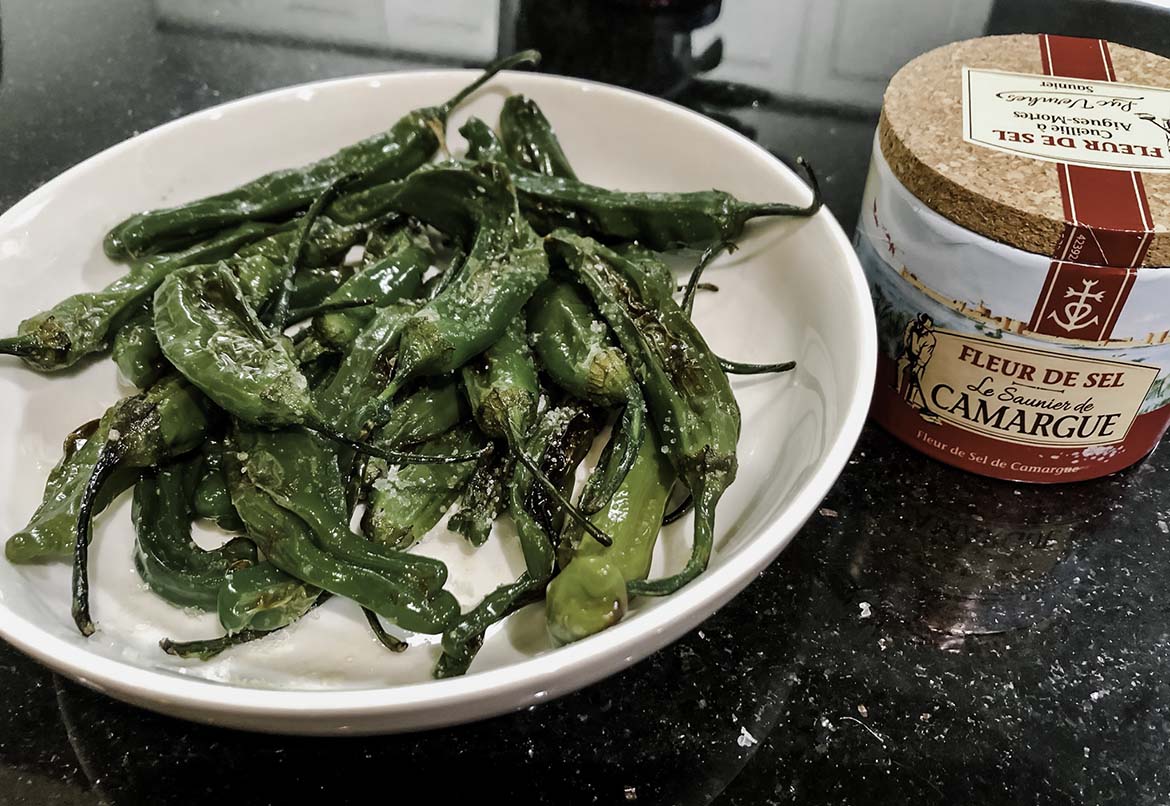“Salt is born of the purest of parents: the Sun and the Sea.”
—Pythagoras
My new favorite find is fleur de sel, a rare form of sea salt hand-harvested by a process that is considerably more complicated than all other salts. It involves collecting, by hand, the delicate thin layer of salt that floats on the surface of the water forming a delicate crust of pyramidal crystals.
Fleur de sel forms under very limited weather conditions. And because it’s harvested by hand, it is more expensive than other salts.
But, oh, so worth it.
It’s moist, crisp flavor resists dissolving because it’s so naturally moist. It’s perfect for adding to dishes just before serving. Fleur de sel is irregular shaped and glistens like diamonds, making it the perfect final touch on virtually any cuisine. It’s even delicious and stunning—yes, it is art!—on desserts.
Its French name translates as “Flower of Salt”.
I buy Le Saunier De Camargue’s Fleur De Sel.

Fleur de sel is a special salt captured from the top layer of sea water. It must be hand-gathered.
Here are some facts:
- Fleur de sel has a much higher amount of moisture than common salt (up to 10% compared to 0.5% for common salt), allowing the crystals to stick together in snowflake-like forms.
- The moisture means that fleur de sel won’t dissolve right away on your tongue, so the taste lingers. Many claim it tastes slightly of lavender.
- Since it’s unrefined, it is not just sodium chloride. Other minerals, like calcium and magnesium chloride, give it a more complex flavor. These chemicals make fleur de sel taste even saltier than other salts.
- Trace mineral content depends upon the location at which skilled employees harvest it, so the flavor varies with point of origin.
Because they scrape it gently from the salt marsh like cream from milk, they often call it “the cream of the salt pans.”
It’s also called “the caviar of sea salts”.
Check out this video that illustrates how they harvest fleur de sel and why it’s so special.
While France is well known for its fleur de sel, the salt is harvested in a few other areas in the world. The video below illustrates how they harvest fleur de sel in the small Aegean island of just 100 inhabitants, Schinoussa, in Greece. There’s no easy way to harvest the salt. It’s a laborious effort. Check it out.
I first learned of this special salt from Ina Garten in her filet mignon recipe found in her Cooking for Jeffrey cookbook. I first mentioned this in my post Staying Curious & Inspired in 2020. I just couldn’t wait to share my find!
The salt is best used as a finishing salt.
I use it on, really—everything. It’s best sprinkled over your finished dish just before serving.
Here’s an example of how you can use it.
In the picture below, my niece Nicole used it to season shishito peppers. Blistered shishito peppers are a delicious quick and easy snack, side dish, or appetizer. They are a thin-skinned, mild, sometimes sweet pepper that hails from Japan. But, be aware, about one in ten are quite spicy. The typical heat range of the shishito peppers runs from 50 to 200 on the Scoville Scale, which isn’t very hot. Compare it to a typical jalapeño pepper, which averages about 5,000 SHU, and it is roughly 100 times milder. I always feel like I win the pepper lottery when I get a spicy one. They are so delicious and I like the kick.
I buy my peppers at Trader Joe’s.
To make blistered shishito peppers, simply toss them with olive oil and then add them in a single layer to a hot pan. Let the peppers sear and blister on one side, then use tongs to turn them over individually to sear on the other side. Remove them to a plate and sprinkle them with Le Saunier De Camargue’s Fleur De Sel .

Blistered shishito peppers are best served with fleur de sel sprinkled just after cooking.
There you have it—from rare, delicate fleur de sel to blistered peppers. The juxtaposition is as perfect as it tastes.
♥
Enjoy!
XOXO



4 comments
Another awesome article Sweetheart! I also love Maldon Salt, from England, and the Welsh salt, Halen Mon is one of my faves! Check the later one out and get on their newsletter because they always send great recipes! I think this one needs to go onto my next newsletter, don’t you??? Miss YOU! Love Andrea
You are such a GEM! I’ll check that salt out. I just never knew that salt could be so unique and diverse. I love that the earth just creates it for us. 🙂 Best to you!
Very interesting. I did not know about this variety. I look forward to trying it. Thanks Debra!
I hope you love it like we do! We are nearly through our first container. We eat it daily. I’d love to hear how you like it. Please let us know! 💕 XOXO